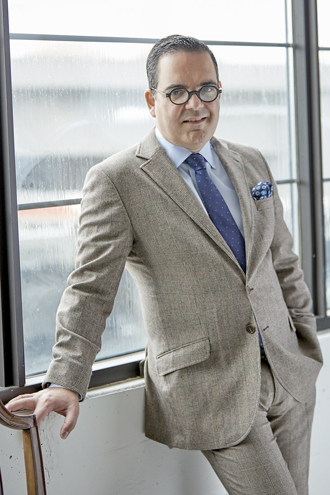Rose Art Museum's new director Luis Croquer believes in good art, good food and the 'aha' moment
 Photo/Stanton J. Stephens
Photo/Stanton J. StephensThe following Q&A will appear in the upcoming fall issue of State of the Arts magazine:
Warm, engaging and endlessly appreciative and curious, Luis Croquer, the new Henry and Lois Foster Director of the Rose Art Museum, is the kind of person who inspires creativity. Artists love to collaborate with him. Bartenders create drinks for him. At a local bar in his recent hometown of Seattle (where he was deputy director of exhibitions, collections and programs at the Henry Art Gallery at the University of Washington), he says, “the bartender and I had a little game. She would ask me what my mood was, and she would make a cocktail for my mood.”
The table is an important metaphor in Croquer’s approach to contemporary art and ideas. “Most interesting conversations take place around food,” he says. “It’s a space that is social and also informal and generous.” The museum, he says, needs to be an open table. “People need to know they can have their own experience, whether it is enjoyable or challenging to like the art over time. The most important thing is how the museum can communicate to people and help them think.”
With deep curatorial expertise and knowledge of the national and international arts communities, Croquer combines intellectual rigor with boldness, says President Ron Liebowitz. “The Rose has undergone a period of rebirth and renewal, and is now poised for even greater prominence. Having a director with Luis’ extraordinary talents is a great gift, for our students and for the international art world.”
Croquer succeeds former Rose director Christopher Bedford, who was named director of the Baltimore Museum of Art in May 2016. The Rose Art Museum and the Baltimore Art Museum are currently co-presenters of artist Mark Bradford at the U.S. Pavilion at the Venice Biennale, the world’s premier showcase for contemporary art.
As he packed up his house in Seattle this summer, Croquer took a break to talk about his vision for the Rose.
You’ve said that museums can’t turn their backs on social issues. Which issues are particularly important to you?
Equity. Racial equity, gender equity. The understanding of human integrity, and creating spaces for true dialogue in the context of a deeply polarized world. And in that context, what can museums be in the 21st century? We need to be ahead of the times. Museums are places for reflection and an aha moment — that idea of slowness can gain momentum again.
Being an immigrant myself, I’ve been thinking about this a lot.
Right. You were born in El Salvador and your father was a diplomat. You have lived pretty much everywhere: Europe, South America, Africa, the Middle East.
It was a great inspiration to travel with my father around the world. I belong everywhere and nowhere at the same time. Belonging to a place is very conceptual to me. The greatest privilege is to know that people are the same. There is no fear about difference, because you see that the similarities or the things that are at the core are the same. Today, even with social media, and people flying more, it is strange that we are not thinking that as human beings we are all the same and that distinct traits only make the world richer.
I’ve been thinking about Brandeis’ origins and the historical moment after World War II, which was a time of great union and forward thinking. There was a desire to rebuild and trust the community again and heal in all kinds of ways. Sometimes we forget that we have that capability.
What don’t you know about Brandeis yet that you need to know?
I am enthusiastic about the people of Brandeis. I want to hear their histories, what they hope for. The best thing about working in a university environment is to work alongside bright minds and learn about what they know. Ideas come from everywhere.
A lot of my work is geared to the community in its broadest sense. The true dimension of a museum is the civic dimension, being a bridge to art and ideas. This concept of the museum as a jewel box, of preaching to the choir, is not interesting, and not why I joined the art world, or the Rose, for that matter.
What can a university museum, especially a university with a social justice mission, contribute to these important dialogues?
The Rose is 50-something and that is really great. You’ve come into your own, and show how you’ve matured, how your personality has developed. The museum has so much to give. We have complementary missions within Brandeis institutions; we are all doing the same work.
Artists have always been involved in politics and social issues. Sometimes they show the work in ways that we recognize, and sometimes it is revealed over time. In a highly charged political time, people recognize passion more in figuration, but abstraction is a great way to convey complex ideas. It may be more stark and hard to read, but it’s there and important. Art has always been there to catch the zeitgeist, to challenge as well as please.
There is a natural distance between people and contemporary art. But people can tell you about amazing moments in the museum and about their individual realizations, and those ideas can be bigger than what we as professionals see. It’s up to us to bring people and art closer. To help people feel that they can come in with their own ideas, and put something of themselves in dialogue with the work.
Categories: Arts





